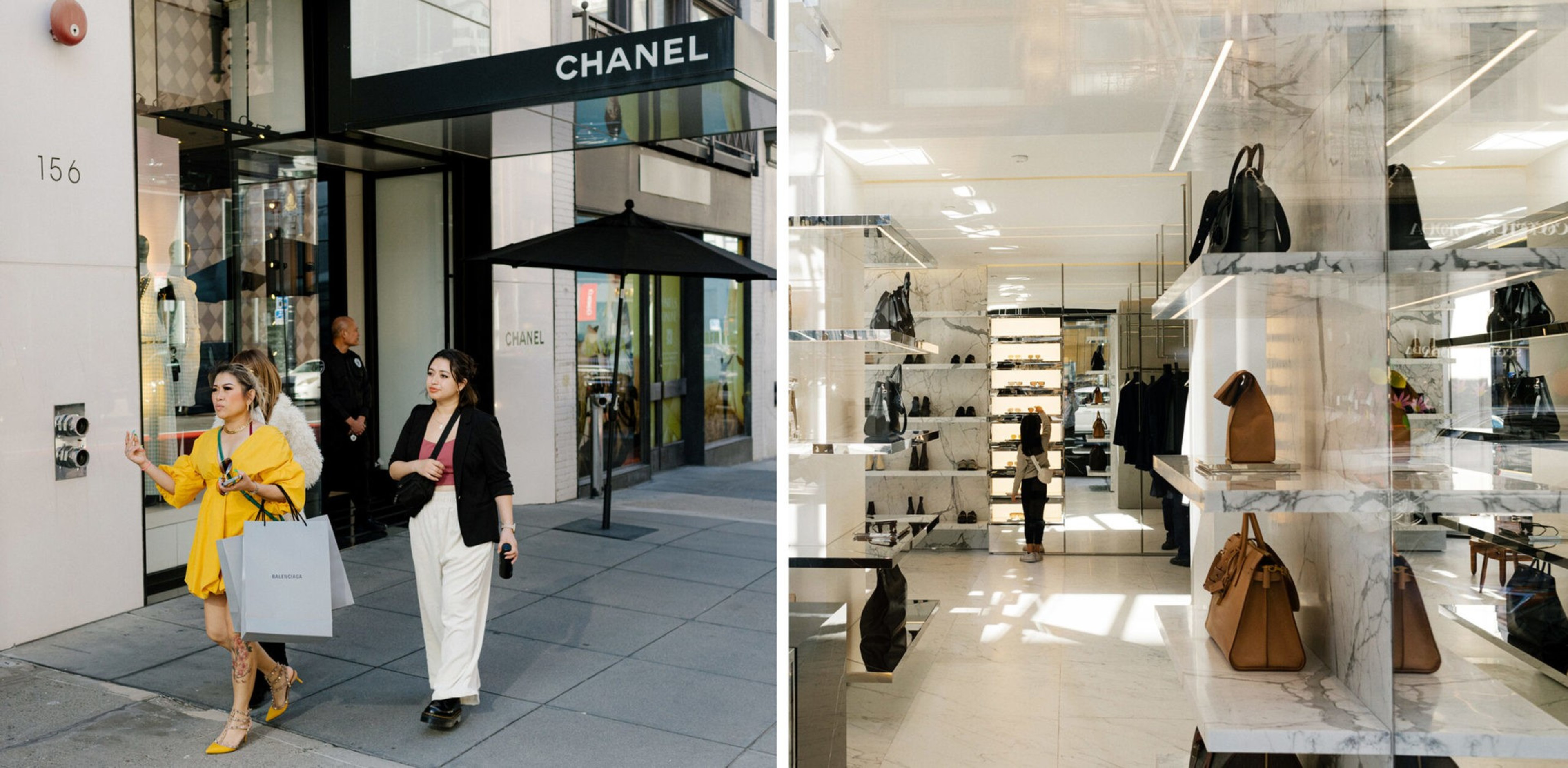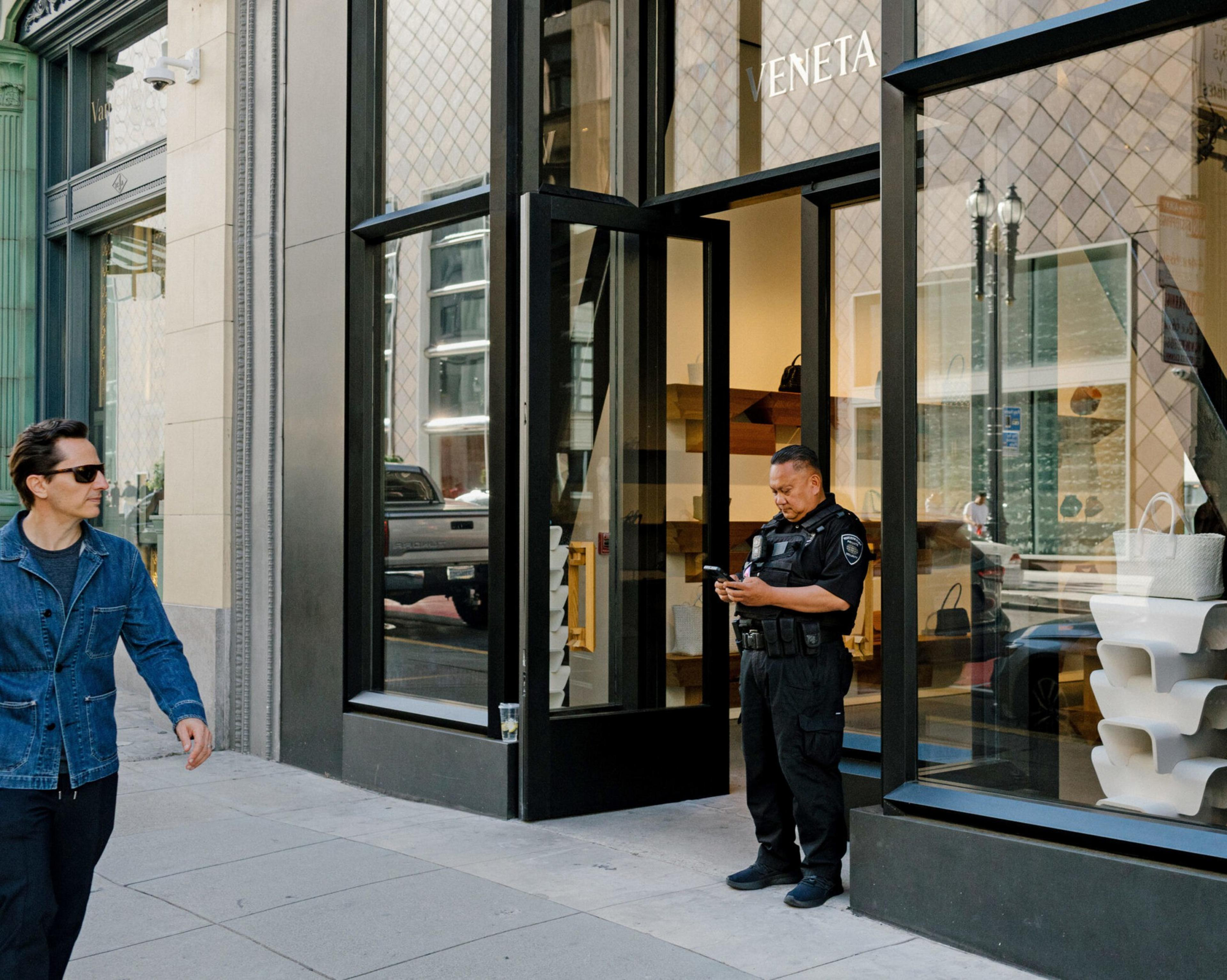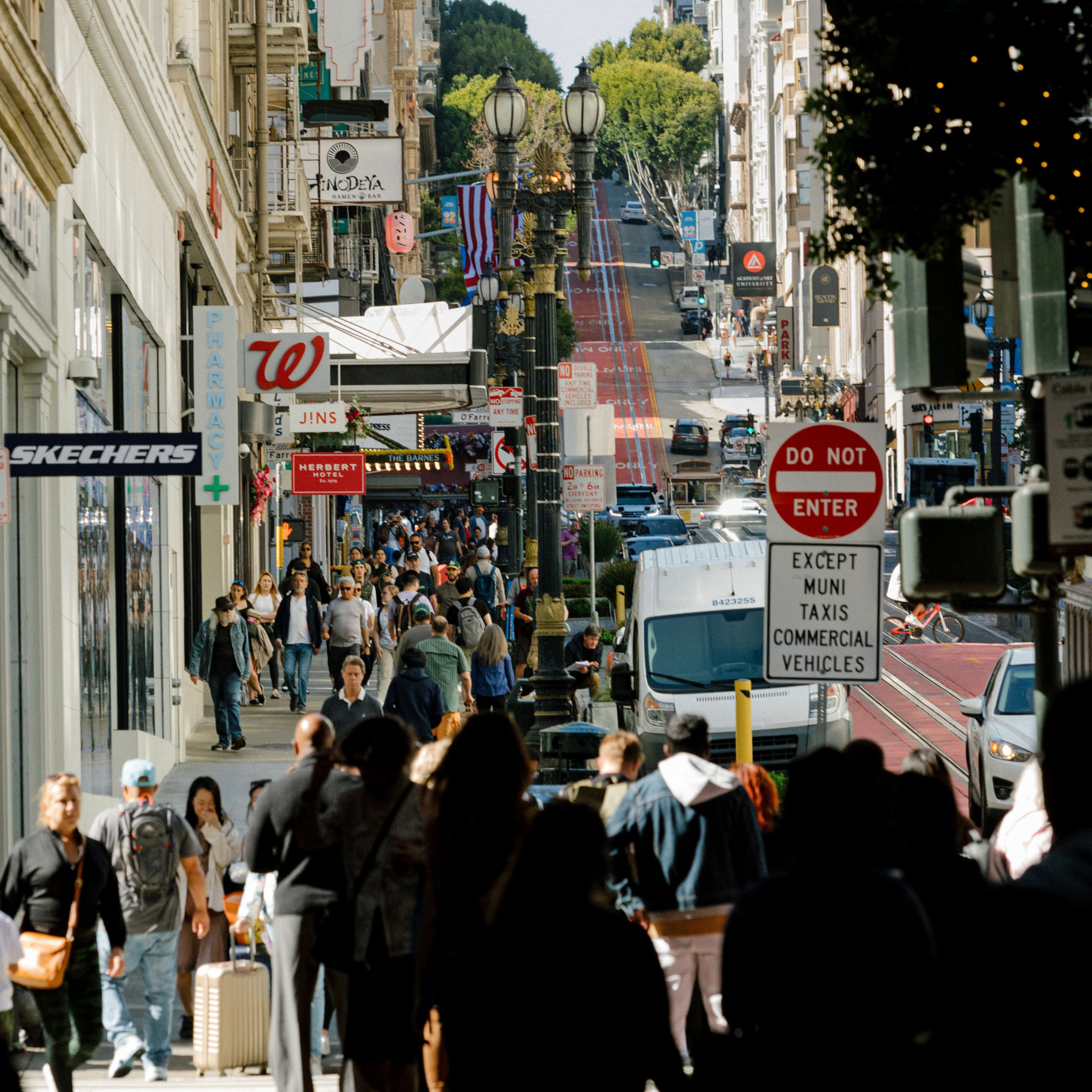Inside pricey furniture retailer Coco Republic in Union Square on a recent weekday, garish red, yellow and black signs advertising a liquidation sale clashed with the tony, understated vibes of $10,000 couches and a wall of decorative sailboats.
The Australian company recently announced that it would close the location at 55 Stockton St.—its first in the United States—less than a year after its opening. In a press statement (opens in new tab), the company cited the economic conditions in Downtown San Francisco and the “safety and well-being of our customers and employees” as reasons behind the closure.
Real estate sources say the underlying story is a bit more complicated. For one, Coco Republic was on a short-term lease after the company took over the property from Crate & Barrel. Another challenge was that the retailer didn’t have an effective strategy for marketing an unfamiliar brand to locals.
Regardless, the announcement—which followed news about the departure of nearby Nordstrom and Whole Foods locations—led to another round of hand-wringing about the future of Union Square, long considered San Francisco’s premier shopping district.
Historically, Union Square has been home to a mix of luxury retailers such as Cartier and Chanel and mid-tier shops like Nike. More recently, though, the area has been the subject of relentless negative headlines that have included high-profile robberies, concerns about homelessness and street conditions, declining foot traffic and prominent store closures.
“What we’re seeing all over is others who are trying to define what San Francisco’s narrative is,” Mayor London Breed said at a press conference this week announcing a $6 million investment in the beleaguered Powell Street corridor leading from Market Street up to Union Square. “We have to change the narrative, but we also have to change the conditions.”
The barrage of retail departures and negative news has many in the city wondering if a central hub for the city’s economy is sliding into irrelevance. Looking closer, however, a picture emerges of a neighborhood in flux, indelibly transformed by a one-two punch of changing shopping habits and the Covid pandemic and evolving into something new.

Kazuko Morgan, a retail broker for Cushman & Wakefield, has worked in Union Square for some two decades. Her name can be found prominently listed on the “For Lease” signs in empty storefronts; in fact, she was the landlord and tenant broker for the Coco Republic deal.
“I’ve never seen a market this challenging in my life,” Morgan said. “But that presents a tremendous opportunity for retailers and buyers because this historically has been one of the most expensive and toughest markets with such little inventory.”

The availability rate in Union Square is 23.5%, according to a first-quarter retail report (opens in new tab) from real estate firm Avison Young. That’s higher than any other Bay Area submarket tracked by the firm, including West San Jose, Downtown Palo Alto and Downtown Walnut Creek. The researchers defined Union Square as the area bounded by Market, Turk, Taylor and Pine streets.
Research from The Standard found massive turnover on the streets of Union Square since the pandemic. After examining historical membership rosters from the Union Square Alliance and other sources of merchant listings, The Standard estimates only 53% of the 203 retailers in business during 2019 are still operating storefronts in Union Square today.
Union Square Alliance CEO Marisa Rodriguez described a domino effect since the pandemic: Store and office closures related to the pandemic followed by civic unrest in 2020, mass looting incidents in 2021 and growing national attention on San Francisco’s challenges with fentanyl and homelessness have eroded the district’s reputation, she said.
“We’ve experienced booms and busts, but we’ve never experienced those booms and busts and a pandemic together,” Rodriguez said.
Colliers retail broker Julie Taylor said Union Square is in a fallow period as the neighborhood shakes off the impacts of the pandemic that led to San Francisco shutting down “too soon, too hard and too long.
“Anthropologie closed in Burlingame about six or seven years ago, and nobody freaked out about it,” Taylor said. “Part of that housecleaning is a really good thing. We are just at the point where we’ve cleaned up the closets, we moved the furniture, but the new stuff hasn’t arrived yet.”
Luxury Matters
Despite the negative headlines, there are signs that some of the world’s most exclusive retailers see opportunity in Downtown San Francisco. Luxury brand Chanel circled the real estate market for years before pulling the trigger and purchasing the Williams-Sonoma building at 340 Post St. for $63 million in 2021.
“There are leases pending. There are leases that are getting signed. And those tenants are taking the long view that it’s still San Francisco,” Morgan said. “It is still one of the most important markets in the world.”
Retail boosters cite San Francisco’s status as a gateway for travel from Asia as well as the city’s high median incomes as drivers of tenant interest in the market.
Other well-known brands have started to make moves in the square. Saint Laurent relocated from its location at 100 Geary St. to a larger space at 90 Grant Ave., Bottega Veneta expanded its flagship store at 124 Geary Ave. and Banana Republic is moving its flagship to 152 Geary St. as part of its repositioning as a premium brand.

But while the luxury segment doubles down in parts of Union Square, mass-market retailers like H&M and Uniqlo, which rely on sales volume and foot traffic to make their numbers, have closed.
Camera data from the Union Square Alliance showed pedestrian traffic in the first four months of the year was up by 27% compared with the same period last year. March 2023 saw a post-pandemic high of 1.17 million visitors for the month, but that’s still “considerably below” 2019 numbers, according to a Union Square Alliance representative.
Union Square, which is also home to around 12,000 hotel rooms, is banking on tourists—particularly monied international travelers from China and elsewhere—coming back and opening their wallets.
“I think the impact of office workers on the kinds of shopping that predominates in Union Square is vastly overstated,” said Michael Berne, president of retail consultancy MJB Consulting. “The far larger piece is tourists.”
International travelers spent $3.7 billion in the city last year—up from $1 billion in 2021 but below the $5.1 billion spent in 2019. But there are signals of a tourism rebound, namely, San Francisco International Airport traffic reaching levels (opens in new tab) that haven’t been seen since March 2020. Tourism officials are eagerly awaiting the return of international tourists who tend to stay for longer and spend a lot of money.

Eric Mendell, the co-owner of Burlingame-based Kerns Fine Jewelry, signed a lease in October to launch two adjacent Rolex and Patek Philippe watch stores at 255 and 259 Post St. slated to open in the first few months of 2024. Mendell said he’s betting on the two brands’ historical cachet drawing in all types of visitors.
When he told colleagues that he was planning on opening a luxury watch store in San Francisco, he said, “95% of the people looked at me as if I was crazy.
“As time has moved on, the consensus now is that it was a ballsy, good move,” Mendell said. “Although there are still people who think I’m crazy.”
Even though entrepreneurs like Mendell are betting on a bright future for the district, the string of bad headlines has had a chilling effect on Union Square’s recovery. A number of deal negotiations have faltered or have been on pause because of the negative news emerging out of the city, brokers said.
“The general sentiment I hear is quite a bit more negative than what I’m seeing on the ground,” said CBRE retail broker Laura Sagues Barr.
The Ground Level
Tourists and visitors dotted the district’s central plaza on a recent sunny afternoon, sipping iced coffees and taking photos of the cascading flowers installed in the park for a promotion called Union Square in Bloom (opens in new tab).
A French tourist in a Golden Gate Bridge baseball cap was sunbathing and waiting for his family to finish shopping at Victoria’s Secret. A young group of Norwegian travelers chatted, smiling after a meal at the Cheesecake Factory. A gleaming Rolls Royce idled in front of the Tiffany & Co. location at 350 Post St.
But even in the central plaza, there are vacancies. San Francisco’s Recreation and Park Department put out a request for proposals (opens in new tab) earlier this year for two concession operators in the square itself.

Police and security guards are highly visible, though deployment is down from a surge during the Christmas shopping season. Retailers say they’ve been heartened by the appearance of officers doing patrols on foot.
Union Square houses the San Francisco Police Department’s only Mobile Command Center, a vehicle that is specifically meant to deter flash mob-style thefts from happening.
Behind closed doors, there is grumbling from tenants around Union Square about shoplifting, homelessness and dealing with people in the throes of mental health crises. And while many of the larger merchants can weather the ups and downs of a muted economic recovery, smaller businesses are often left behind.
The owner of Spectacles of Union Square, who said he didn’t want to be named, peeked his head out of his door.
“How do you think I fucking feel? I own a small business in San Francisco,” he said when asked about the current situation. “I have to keep my door locked during business hours.”

On the far end of Maiden Lane, Iron Horse Cocktails caps an alley marked by vacant storefronts. Only a few high-end boutiques remain, many of which are open by appointment only.
Angela Voloshyna, the bar’s owner, opened Iron Horse in 2017 and said business boomed for a while: A regular clientele of office workers was bolstered by shoppers patronizing other stores nearby. But the pandemic hit, and Voloshyna was forced to close two of her four bars in the city.
Now with business back to around 70% of pre-pandemic revenue, she considers herself fortunate. She said she’s appreciative of the community ambassadors who greet visitors and monitor the crowd, and the cleaning and other services provided by the Union Square Alliance, but the problems being faced by the city go far beyond what one group can contend with.
“I think they do everything in their power, but the government of the city needs to do some work as well,” Voloshyna said. “It feels like a Band-Aid on a big wound.”
Reshaping the Square
In the post-pandemic haze, it’s easy to forget that a larger conversation about the transformation of Union Square was already taking place before the pandemic (opens in new tab).
Sales growth had started to stall, retail vacancies had started to creep up, and the same conversations about e-commerce eating into brick-and-mortar sales were taking place.
Rodriguez said the crisis in San Francisco’s Downtown allowed the Union Square Alliance to lobby for planning code changes to “right-size” the amount of retail space in the neighborhood that she says were long overdue.

“Pre-pandemic, we started seeing signs that the country was overbuilt for retail,” Rodriguez said. “I think it is clear that we had room to be other things, as well as retail.”
Legislation co-sponsored (opens in new tab) by the mayor and Board of Supervisors President Aaron Peskin put forward zoning changes to allow for more flexibility and uses in Union Square.
Among other changes, their proposal opens up residential and office uses for floors above ground level. It also expands the definition of ground-floor retail to allow more tenants, such as entertainment businesses and flexible retail workspaces, to move in. The alliance’s strategic plan (opens in new tab) also includes the use of alleys for entertainment and programs, sanitation and safety improvements and investment in the expansion of luxury retail.
Not everyone thinks it will be enough.
“They should have done this five years ago,” Morgan said. “OK, great, we’re allowing office? Well, look where the office market is right now.”
But signs of new life are emerging.

At the former Macy’s Men’s Store at 100 Stockton St., high-end Japanese-Peruvian restaurant brand Chotto Matte is scheduled to open in the summer. On the fourth and fifth floors of the building, tech-oriented co-working and events space Convene is opening its first San Francisco location in October.
“It takes our residents to come back Downtown to shop and eat. It takes people having their friends and relatives come here. It takes companies to get people back to work in their offices,” Morgan said. “Everybody needs to play a part in turning this around.”
